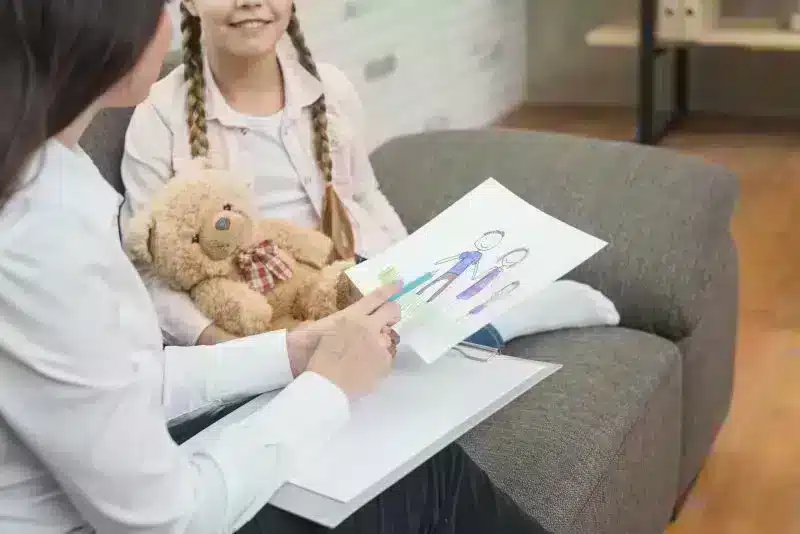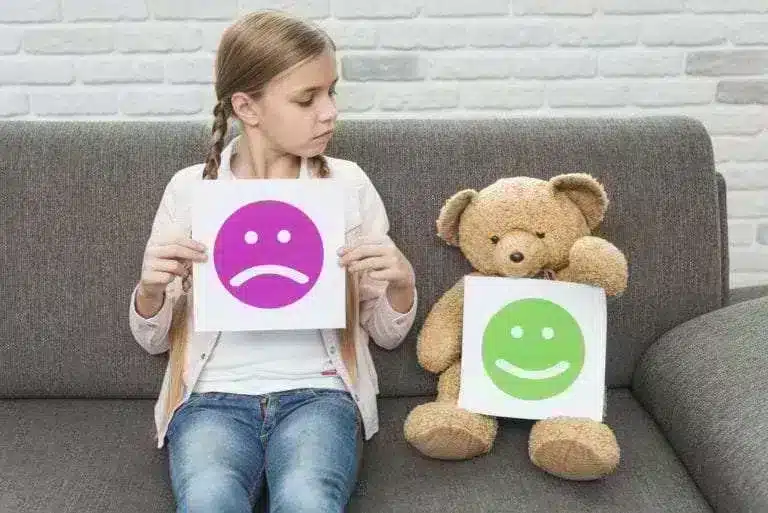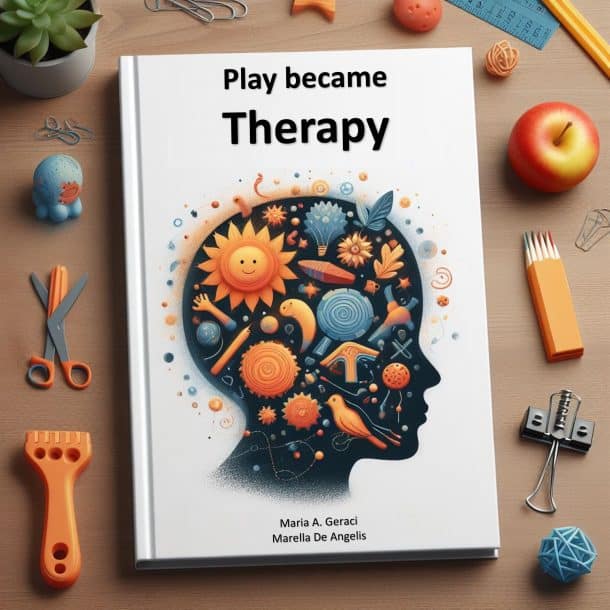COGNITIVE BEHAVIORAL PLAY THERAPY
What is Play Therapy and How does it works?
CBPT DEFINITION
Cognitive Behavioral Play Therapy is a psychotherapy approach aimed at children, including pre-schoolers, and their parents and represents a possible psychotherapy path to intervene in emerging psychological distress. Specifically, it uses therapeutic play to help the child learn how the world works, learn how to relate to others, understand how to deal with difficulties and find possible solutions.
The psychotherapist, who uses this model, aims to directly involve the child with different problems, in the therapeutic process and integrates cognitive and behavioral techniques within play therapy. Playful activity, as well as nonverbal forms of verbal communication, are used to promote the development of problem-solving skills.
Therefore, Cognitive Behavioral Play Therapy proposes a conceptual framework based on the principles of cognitive behavioral therapy, and making them adapted to the developmental level of the child.
Designing CBT interventions in play therapy facilitates children’s involvement in therapy. By providing these types of developmentally appropriate interventions, the psychotherapist helps children benefit from a type of psychotherapy that may otherwise be inaccessible. Through Cognitive Behavioral Play Therapy, you can learn more adaptive coping skills and offer structured, goal-oriented activities. It also provides a space where the child can bring out spontaneous input into the session and successfully express their experiences.
In light of scientific evidence, this model included in a developmental psychotherapy process can provide immediate and concrete feedback on the psychological distress of children and their families.


ORIGINS OF CBPT
Knell (1998) further developed the approaches of Beck (1976), Ellis (1971), and Bandura (1977) and other theorists, using play to work with children. Knell used structured approach, being directive and goal-oriented, to teach children to think of a new way to play, solve their problems, and build relationships. The application of CBPT includes the assessment and introduction of a customized intervention tailored to “increase behavioral competence” (p. 30). The therapist creates scenes from the child’s life and uses models, role-playing games, desensitization and other techniques to help the child change their behavior (Knell, 1998).
According to Knell (1993a, 1993b, 1994, 1997, 1998), CT could be applied to children if presented in a way accessible to them. Puppets, stuffed animals, books and other toys can be used to model children’s cognitive strategies, verbalizing the ability to solve problems or find possible solutions to a problem similar to the child’s.
CBPT, as conceptualized by Knell (1993a, 1993b, 1994, 1997, 1998, 1999, 2000; Knell & Moore, 1990; Knell & Ruma, 1996, 2003; Knell & Beck, 2000, Knell & Dasari, 2006) was developed for use with children between 2½ and 8 years and is based on cognitive, behavioral and traditionally therapies. CBPT is sensitive to developmental issues and emphasizes the empirical validation of effectiveness of interventions.
TREATMENT DESCRIPTION: CBPT STAGES
For children, play is a natural and developmentally appropriate means of communication. So, children can use toys as their words and play as communication/language.
CBPT is divided into several phases, described as introductory/orientation, assessment, middle, and termination stages.
- Introductory/orientation
During the initial interview, the therapist must help the parents understand how best to prepare the child for their first session and what explanation may be most developmentally suitable for him. So, can be recommended books such as “A Child’s First Book About Play Therapy” (Nemiroff & Annunziato, 1990). - Assessment
The aim of assessment is to define the targets and a treatment plan. In addition to a parent interview, it is important to provide a observation of familiar play and observation of child spontaneous play. In summary, the assessment includes parent report inventories (e.g., Child Behavior Checklist, Achenbach, 1991), familiar and children play assessment, The Puppet Sentence Completion task (Knell, 1992; Knell, 1993a; Knell, 2018, Knell & Beck, 2000) or therapist-created measures. - Middle
The therapist develops a treatment plan and the therapy focuses on increasing and reinforcement of the child’s self-control, sense of accomplishment, and learning more adaptive responses to deal with specific situations. Depending on the presenting problem, the therapist chooses the most appropriate cognitive and behavioral interventions using specific play techniques, to which the child responds most. The interventions must be evaluated carefully, with as much specificity as possible related to the intervention and the child’s specific problems/concerns. - Termination
During this phase, the child and the family are prepared for the end of therapy. As the treatment nears its end, the child deals with the reality of termination and faces the feelings connected to it.
For a more complete description of these stages in CBPT, see Knell (1999).
Level of development of the child: Play Therapy for children
In order for an intervention to be appropriate, its complexity must consider the child’s developmental stage. The CBPT therapist should:
- focus on the child’s strength and abilities rather than focusing on weaknesses;
- focus on experiential interventions that incorporate play rather than complex and verbal skills;
- encourage and facilitate language to described experiences and emotions.
The child’s vocabulary is still often quite limited. Young children often benefit from the opportunity to learn to associate behaviors with their feelings and express feelings in more adaptive language-based ways.

In CBPT, the balance between structured and goal-oriented activities and unstructured activities in which child’s spontaneity emerges is fundamental.. Unstructured and spontaneous information is critical because it allows the therapist to obtain many clinical information, that the child feeling in a safe context has the opportunity to bring out.
The child expresses his needs through play and the therapist in recognizing them gives him all the expressive space without intervening and interpreting, but accepting and recognizing the precious moment of communication. Thanks to this space, structured therapy can plan an intervention that involves teaching more adaptive behaviors and strategies.
REFERENCES CBPT
- Achenbach (1991). Manual for the Child Behavior Checklist/4-18 and 1991 profile. Burlington, VT: University of Vermont, Department of Psychiatry.
- Axline, V. (1947). Play therapy. New York: Ballantine Books.
- Bandura A. (1977). Social Learning Theory, Prentice Hall, Englewood Cliffs, NJ.
- Beck A. (1964). Thinking and depression: 2. Theory and therapy. In Archives of General Psychiatry, 10.
- Beck A. (1976). Cognitive therapy and emotional disorders, New York: Meridian. T.
- Ellis (1971). An experiment in emotional education. Educational Technology, Reprinted: New York, Institute for Rational-Emotive Therapy.
- Knell, S. M. (1993a). To show and not tell: Cognitive-Behavioral Play Therapy in the treatment of Elective Mutism. In T.Kottman & C.Schaefer (Eds.) Play Therapy in Action: A casebook for practitioners. (pp. 169-208). New Jersey: Jason Aronson.
- Knell, S. M. (1993b). Cognitive-behavioral play therapy. Northvale, NH: Jason Aronson.
- Knell, S. M. (1994). Cognitive-Behavioral Play Therapy. Directions in child and Adolescents Therapy. (pp.1-13). New York: The Hatherleigh Company, Ltd (Reprinted in The Hatherleigh Guide to Child and Adolescent Therapy).
- Knell, S.M. (1997). Cognitive-Behavioral Play Therapy. In K. O’Connor & L. Mages (Eds.). Play Therapy Theory and Practice: A comparative presentation(pp.79-99). New York: John Wiley and Sons.
- Knell, S. M. (1998a). Cognitive-behavioral play therapy. Journal of Clinical Child Psychology, 27, 28-33.
- Knell S. (1998b) Il gioco in psicoterapia : nuove applicazioni cliniche, Edizione italiana a cura di Francesca Pergolizzi McGraw-Hill Companies
- Knell, S.M. (1999). Cognitive-Behavioral Play therapy. In S.W. Russ & T. Ollendick (Eds.) Handbook of psychotherapies with children and families (pp.385-404) NY: Plenum
- Knell S.M. (2000). Cognitive-Behavioral Play Therapy with children with fears and phobias. In H.G. Kaduson & C.E.Schaefer (Ed.). Short term therapies with children(pp.3-27). NY:Guilford.
- Knell, S.M. (2018). Puppet Sentence Completion Task. In A.A. Drewes & C.E. Schaefer (Eds.). Puppets in Play Therapy: A Practical Guidebook. (pp. 59-73). Routledge Press.
- Knell, S.M. & Moore, D. J. (1990). Cognitive-behavioral play therapy in the treatment of encopresis. Journal of Clinical Child Psychology, 19(1), 55-60.
- Knell, S.M. & Ruma, C. D. (1996). Play therapy with a sexually abused child. In M. Reinecke, F.M. Dattilio, & A. Freeman (Eds.). Cognitive therapy with children and adolescents: a casebook for clinical practice (pp.367-393). NY: Guilford.
- Knell, S.M. & Ruma, C.D. (2003). Play Therapy with a sexually abused child. In M.A. Reinecke, F.M. Dattilio & A.Freeman (Eds.). Cognitive Therapy with children and Adolescents: a casebook for cli ical practice. (2nd ed.) (pp. 338-368). NY:Guilford.
- Knell, S.M.& Beck, K.W. (2000). Puppet Sentence completion Task. In K Gitlin-Weiner, A. Sandgrund, & C.E. Schaefer. (Eds.) Play Diagnosis and Assessment, 2nded. (pp. 704-721). NY: Wiley.
- Knell, S.M. & Dasari M. (2006). Cognitive-Behavioral Play Therapy for Children with Anxiety and Phobias. In H.G. Kaduson & C.E. Schaefer (Ed.). Short term therapies with children (2nd ed.) (pp.22-50). NY:Guilford.

